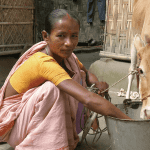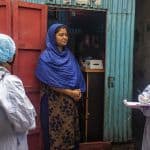Preparing Community Health Workers to Deploy the COVID-19 Vaccine: Five Lessons on Digital Training Learned From the Ebola Crisis
Last week India reported grim new records in daily COVID-19 cases and deaths, and it recently passed the threshold of 200,000 deaths; some suggest these numbers are highly underestimated. Meanwhile, deaths in the United States are nearing 600,000. Statistics like these can either spur people to act or result in inertia. But there is a ray of hope, as COVID-19 vaccines are making their way to our most vulnerable: Hopefully, everyone who needs or wants a COVID-19 vaccination will soon have access, in both the developed and developing world.
Five years ago, Grameen Foundation joined the Ebola vaccine Deployment, Acceptance and Compliance (EBODAC) consortium — a public-private partnership between the London School of Hygiene and Tropical Medicine, Janssen Pharmaceutical N.V., World Vision and Grameen Foundation, and funded by the Innovative Medicines Initiative — to respond to a very different health crisis: the Ebola outbreak in West Africa. Ebola claimed the lives of over 11,000 people between 2014–2016. But in the years since the outbreak, a series of experimental vaccine regimens tested in Sierra Leone by Janssen Pharmaceutical Companies of Johnson & Johnson have been recommended for approval, providing hope that such an outbreak could be minimized or prevented in the future.
Grameen Foundation, in partnership with World Vision, supported the Ebola vaccine trials in Sierra Leone by digitally enabling community health facilities and part-time community health workers (CHWs) for the Ministry of Health and Sanitation of Sierra Leone. This support included several components: We helped community health facilities digitally schedule appointments for trial participants to receive their vaccines using Grameen’s Mobile Technology for Community Health platform, and reminded them of their booster vaccine administered eight weeks later, as well as their follow-up medical appointments. And we conducted virtual refresher trainings on outbreak responses and vaccinations with CHWs using an interactive voice response (IVR) system Grameen called the Mobile Training and Support (MOTS) service.
Our experience with Ebola provided us with important lessons on how to leverage digital solutions to address disease outbreaks and other health crises. These lessons can help inform efforts to deploy COVID-19 vaccinations through CHWs. We’ll share five of those lessons below.
Vaccination Appointment Reminders Matter, and So Do the Details
For vaccinations that require multiple inoculations and follow-up appointments, automated appointment reminders using IVR and SMS text messages for patients can be an important complement to any vaccination and communication effort. Our research on the Mobile Technology for Community Health platform found that all the respondents interviewed who received either the IVR or text message reminders for their vaccinations or medical appointments liked them, and 80% of them reported that the IVR was very easy to understand. We also learned that the majority preferred the female voice over the male voice that was interchangeably used in the IVR system, as they thought it sounded more polite. And we found that the time the message was sent mattered since respondents reported that their phones were turned off or out of range of the mobile network at certain times of the day (as they were on their farms). Almost three-quarters of the respondents who were sent visit reminder messages never missed a clinic appointment. And among those who missed their appointment but were reminded to make a new appointment, most were able to reschedule within three days of their original appointment date. Trial participants were also asked what type of information they would like to receive through IVR or text messages if an outbreak were to occur, and the top three mentioned were: a.) how to protect myself or others, b.) how to treat myself or others, and c.) the location of the outbreak.
Understand and Support Community Health Workers’ Digital Readiness
Prior to the MOTS IVR training for CHWs, Grameen conducted an assessment to identify and determine their mobile phone ownership and functionality. To participate, CHWs needed to have some degree of digital literacy, and their phones had to have at least call/text capabilities — but they were not required to own smartphones. We found that there were enough CHWs who owned mobile phones and who had sufficient digital literacy to test MOTS and to navigate the IVR trainings. However, the findings also revealed the importance of considering mobile phone charging capabilities (solar chargers were in dire need), and the need to ensure that mobile network connectivity was reliable enough to receive messages. Additionally, while mobile networks and smartphone ownership are growing at breakneck speed, rural and remote frontline workers like CHWs still need access to information that they can receive on feature phones.
High Tech and High Touch are Needed
A key benefit of using IVR trainings for CHWs is the benefit of not having to gather these workers together, when social distancing is necessary to limit their exposure to the very diseases they work to prevent. However, most CHWs who used the MOTS system had received prior in-person trainings on vaccinations and disease outbreaks, so MOTS served as a reminder of the key information they needed to help keep their communities safe. We found that even when digital tools are available, a blended educational approach that combines in-person and digital trainings is needed, as CHWs required some hand-holding to use the system and solve problems accessing the content.
Keep It Super Simple
While IVR naturally forces education designers to prioritize key messages, an important lesson we learned is that the use of IVR greatly increases the need for simple training messages. While the IVR education was designed to mirror key messages provided during the Ministry of Health and Sanitation’s in-person training for CHWs, our research suggested that too many health messages were included, resulting in a suboptimal level of knowledge on critical messages, such as being able to recognize danger signs of Ebola. The research also suggested that CHWs may have experienced fatigue in listening to the IVR sessions over time, as fewer CHWs answered knowledge questions correctly in the latter sessions they received. Moreover, the research results revealed generally low baseline levels of knowledge on content that CHWs had already received during in-person trainings, suggesting that those trainings may not have been effective in knowledge acquisition. This points to the potential need to simplify in-person training as well.
Digital Technology Can be Cost-Effective and Convenient for Implementers and CHWs Alike
Grameen conducted a cost assessment on MOTS and estimated that the cost for maintaining a MOTS refresher training approach was approximately 50% less than in-person refresher trainings. CHWs were also able to engage with the training on their own time, providing them with flexibility and saving up to two hours in time they would have otherwise used for in-person travel and scheduling. While IVR should never fully replace in-person trainings, MOTS enabled dramatically more efficient and widespread community health outreach, built engagement with decentralized health workers, and provided an opportunity to test whether remote learning could further safeguard CHWs and their communities in the case of health emergencies.
CHWs are the backbone of many countries’ health systems, and they will be critical for scaling vaccine information and inoculations. For health systems and other stakeholders preparing for COVID-19 vaccine deployment, we hope these lessons gained from using MOTS for the Ebola vaccine trials will help inform successful training, information and vaccination campaigns. We’re all counting on it.
Monica Amponsah is Regional Program Manager, Bobbi Gray is Research Director, and Gigi Gatti is Director of Technology for Development at Grameen Foundation.
Photo courtesy of World Bank / Vincent Tremeau.
- Categories
- Coronavirus, Health Care, Technology



